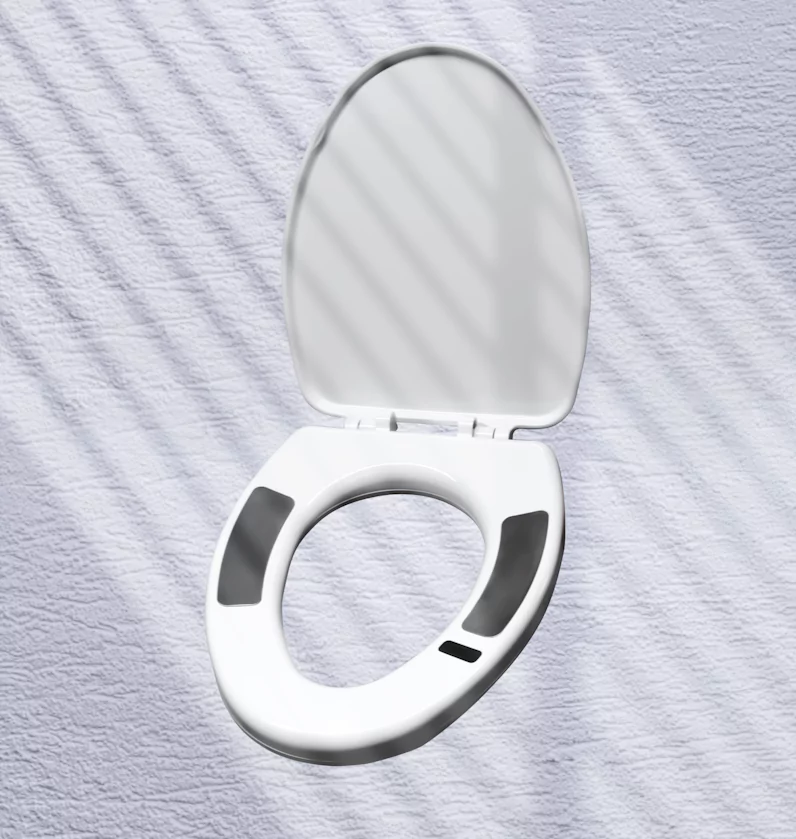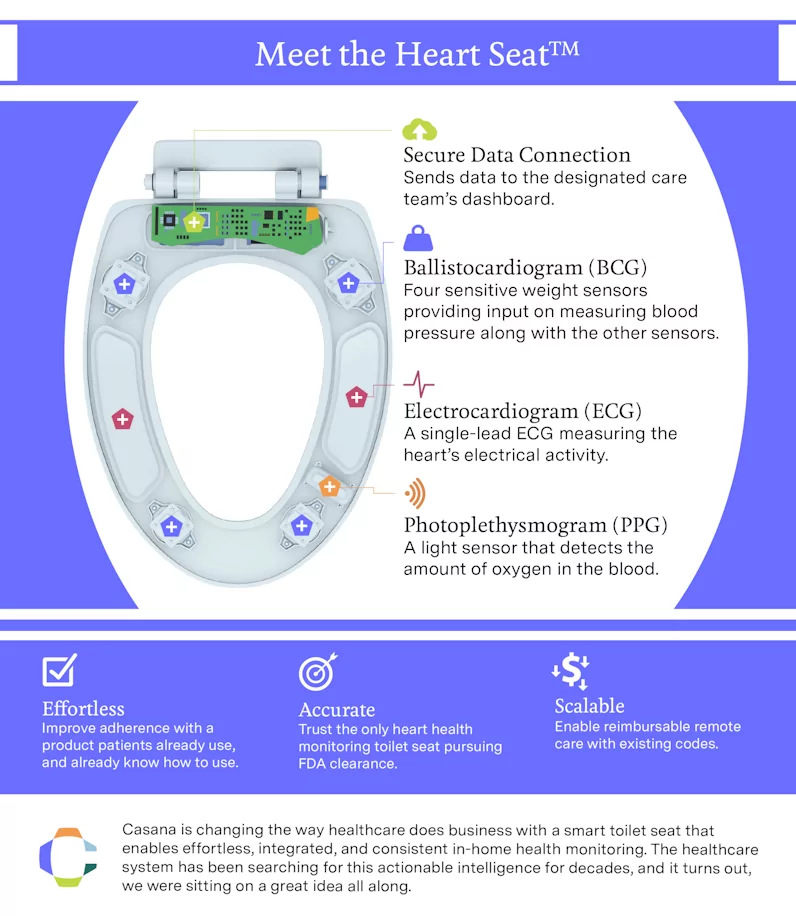Flush Your Worries Away: The Smart Toilet Seat Revolutionizing Healthcare
Published: March 22, 2023
Right under our noses
In 2014, a PhD Engineering student at the Rochester Institute of Technology (RIT), turned an obsession with the future of healthcare into a unique opportunity presented by toilet tech advancement. Nicholas Conn, Casana’s founder and CSO, discovered a new frontier for in-home medical monitoring devices, and it turned out to be in the bathroom.
“The biggest challenge was folks not taking their measurements, not using devices, not wanting to make these massive behavioral changes that are required.” – Nicholas Conn
Although in-home monitoring devices exist for patient use, ensuring their accurate and consistent usage remains a challenge. In search of a solution, Nicholas Conn collaborated with his advisor to brainstorm ideas. While considering different objects like chairs, steering wheels, and computer mice, they rejected them for lacking the necessary direct skin contact. Eventually, Conn arrived at an unconventional idea. “Let’s throw electrodes on a toilet seat,” he suggested excitedly.
Seven years after the idea’s inception, Conn teamed up with Forbes Under 30 alum Austin McChord.
“I’ve been down this road before, bringing a quirky, weird idea to market… I don’t know anything about the medical space, but I do know how to get other great people around the table and how to build a company,” says McChord, founder of data recovery startup Datto, which sold to Vista Equity Partners in 2017 for $1.5 billion and is now publicly traded with a $5.8 billion market cap.
“When Austin came to us with the idea, we were going to back him on virtually anything he wanted to do, that’s how good he is,” says David Fialkow, General Catalyst cofounder. The leadership team at Casana also includes former General Catalyst investor Olivia Lew and co-founder David Borkholder, Conn’s former advisor and RIT professor.
When it came to building a smart toilet seat, it was not quite as simple as slapping on a few sensors and calling it a day.
“The initial data that comes out if you just strap electrodes to somebody’s bottom-side is not great,” says McChord. “It’s only through incredible amounts of algorithmic filtering that you get the medical grade data that’s actually valuable.”
The initial development of these algorithms have been published in the Journal of Medical Internet Research mHealth and uHealth. These papers demonstrate how the prototype seat can measure blood pressure, stroke volume, and blood oxygenation with clinical grade accuracy consistent with the ‘gold standard’ for other medical equipment.
Toilet seats as a service
Remote patient monitoring devices often face the challenge of low usage rates not because of any issues with device accuracy or quality, but rather due to patients’ reluctance to use them. Despite the fact that using smartwatches or blood pressure cuffs is not particularly onerous, incorporating them into one’s daily routine can be challenging. For many, a toilet seat is something that is used every single day without a second thought.
“It’s very approachable,” says Conn.
“If we do our job perfectly,” McChord chimes in, “You’ll never know you have one. The Heart Seat feels no different than any other toilet seat.”

With the objective of minimizing the $219 billion expenditure on cardiovascular disease in the US each year, the Heart Seat has been designed to necessitate no charging, reminders, or modifications to patients’ daily habits. The seat has been created to monitor the heart health of individuals who suffer from chronic ailments. Doctors will prescribe the seat, which will track patient data over an extended period. By analyzing the data, patients and physicians can acquire vital insights that will help them determine changes in health and the efficacy of treatments.
With its large form factor, the Heart Seat does not face the typical challenges of miniaturization that novel technologies often struggle with. The seat includes three sensors: an electrocardiogram, a photoplethysmogram, and a ballistocardiogram. Each of these sensors help identify key vital signals.
“There are definitely no cameras or microphones,” says McChord, having spent years working on sensitive data storage at Datto. “Our goal is to be a medical device and to improve your life… we are not an app on your phone that’s going to sell data to Facebook or Google.”

The Heart Seat will be the only FDA cleared toilet seat focused on heart health monitoring, focused on improving remote patient monitoring by effortlessly capturing actionable intelligence on chronic conditions. Clinicians claim the Heart Seat can change the way we do business.
Want to learn more about the Heart Seat? Visit Casana for more information.
Recommended insights
Casana Announces the Appointment of Shikha Anand, M.D., As Chief Medical Officer
ROCHESTER, N.Y., June 13, 2023 (GLOBE NEWSWIRE) – Today, Casana, the industry leader in monitoring heart health through smart toilets, announced the appointment of Shikha Anand, M.D. MPH, as Chief Medical Officer. Casana is dedicated to...Read More
Bridging the ‘Death Gap’; and other Inequalities of US Healthcare
As we develop novel medical devices here at Casana, one of our core design principles is inclusivity. Our focus on inclusivity stems from the need to address systematic disadvantages which are pervasive within the United States...Read More
How A Smart Toilet Seat Can Empower Older Adults to Age in Place with Confidence
Imagine a toilet seat that monitors your health behind the scenes. That's the power of a smart toilet seat, especially for older adults looking to age in place with integrity. Don’t believe us? In a recent...Read More
